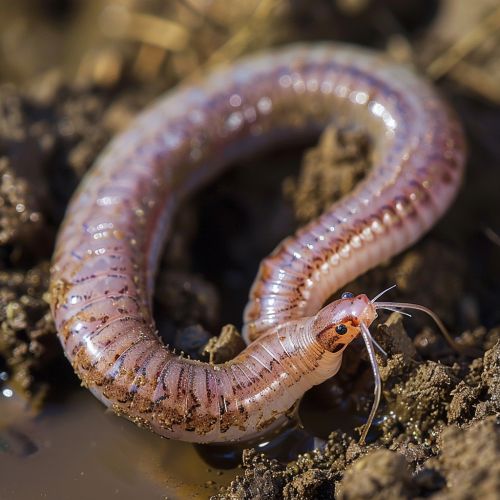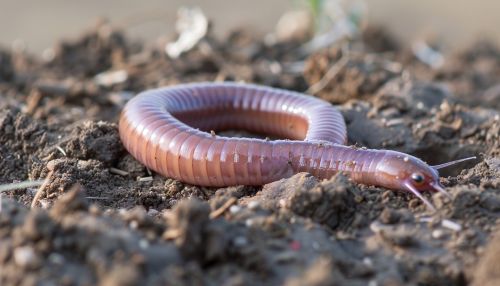Worms
Introduction
Worms are a diverse group of invertebrate animals that belong to several different phyla. They are elongated, soft-bodied organisms that can be found in a variety of habitats, including soil, freshwater, and marine environments. Worms play crucial roles in ecosystems, such as decomposing organic matter, aerating soil, and serving as a food source for other animals. This article delves into the biology, classification, and ecological significance of worms, providing a comprehensive overview of these fascinating creatures.
Classification
Worms are not a single taxonomic group but rather a collection of various phyla that share similar morphological characteristics. The major phyla that include worms are:
Annelida
The phylum Annelida consists of segmented worms, including earthworms, leeches, and polychaetes. Annelids are characterized by their segmented bodies, which are divided into repeated units called metameres. Each segment contains a set of organs and, in many species, bristles called setae.
Nematoda
The phylum Nematoda includes roundworms, which are unsegmented and have a cylindrical body shape. Nematodes are abundant in soil and aquatic environments and can be free-living or parasitic. They play essential roles in nutrient cycling and can also cause diseases in plants, animals, and humans.
Platyhelminthes
The phylum Platyhelminthes consists of flatworms, which have a flattened body shape. This group includes free-living species like planarians and parasitic species such as tapeworms and flukes. Flatworms lack a specialized respiratory and circulatory system, relying on diffusion for gas exchange and nutrient distribution.
Nemertea
The phylum Nemertea, or ribbon worms, are characterized by their long, slender bodies and a unique proboscis used for capturing prey. Ribbon worms are mostly marine and can range from a few millimeters to several meters in length.
Other Phyla
Other phyla that include worm-like organisms are Sipuncula (peanut worms), Priapulida (penis worms), and Echiura (spoon worms). These lesser-known groups also contribute to the diversity of worm species.
Anatomy and Physiology
Worms exhibit a wide range of anatomical and physiological adaptations that enable them to thrive in various environments. This section explores the key features of different worm groups.
Body Structure
Worms generally have elongated, cylindrical, or flattened bodies. The body plan of worms can be segmented (as in annelids) or unsegmented (as in nematodes and flatworms). Segmentation allows for greater flexibility and mobility, while unsegmented worms often rely on a hydrostatic skeleton for movement.
Digestive System
The digestive systems of worms vary significantly among different phyla. Annelids have a complete digestive tract with a mouth, pharynx, esophagus, crop, gizzard, and intestine. Nematodes also have a complete digestive system but lack specialized structures like the crop and gizzard. Flatworms, on the other hand, have an incomplete digestive system with a single opening that serves as both mouth and anus.
Nervous System
Worms possess a simple nervous system that includes a brain or cerebral ganglion and a ventral nerve cord. In annelids, the nervous system is more complex, with segmental ganglia and a double ventral nerve cord. Nematodes have a simpler nervous system with a nerve ring around the pharynx and longitudinal nerve cords. Flatworms have a ladder-like nervous system with paired nerve cords and transverse connections.
Reproductive System
Worms exhibit a variety of reproductive strategies, including sexual and asexual reproduction. Annelids are typically hermaphroditic, possessing both male and female reproductive organs, and can reproduce through cross-fertilization or self-fertilization. Nematodes have separate sexes, with males and females often differing in size and morphology. Flatworms can reproduce both sexually and asexually, with some species capable of regenerating from fragments.


Ecology and Habitat
Worms occupy a wide range of habitats and play essential roles in ecosystem functioning. This section explores the ecological significance of worms and their interactions with other organisms.
Soil Ecosystems
Earthworms are key players in soil ecosystems, where they contribute to soil structure, nutrient cycling, and organic matter decomposition. By burrowing through the soil, earthworms create channels that improve aeration and water infiltration. Their feeding activities break down organic matter, releasing nutrients that are essential for plant growth.
Aquatic Ecosystems
Many worms, such as polychaetes and nematodes, inhabit aquatic ecosystems. Polychaetes are abundant in marine environments, where they play roles in sediment stabilization and nutrient cycling. Nematodes are found in both freshwater and marine habitats, where they contribute to the decomposition of organic matter and serve as prey for other organisms.
Parasitism
Several worm species are parasites that infect plants, animals, and humans. Parasitic nematodes, such as the root-knot nematode, cause significant damage to crops, leading to reduced yields and economic losses. Parasitic flatworms, including tapeworms and flukes, infect a wide range of hosts and can cause serious diseases. Understanding the life cycles and transmission pathways of parasitic worms is crucial for developing effective control measures.
Evolution and Fossil Record
The evolutionary history of worms is complex and spans hundreds of millions of years. This section delves into the origins and diversification of different worm groups.
Early Evolution
The earliest worm-like organisms appeared during the Precambrian period, over 600 million years ago. Fossil evidence suggests that these early worms were simple, soft-bodied organisms that lived in marine environments. The Cambrian explosion, around 541 million years ago, saw a rapid diversification of worm-like animals, including the ancestors of modern annelids, nematodes, and flatworms.
Fossil Record
The fossil record of worms is limited due to their soft-bodied nature, which makes fossilization rare. However, some exceptional fossil sites, such as the Burgess Shale in Canada, have preserved detailed impressions of ancient worms. These fossils provide valuable insights into the morphology and diversity of early worm species.
Molecular Phylogenetics
Advances in molecular phylogenetics have revolutionized our understanding of worm evolution. By analyzing DNA sequences, scientists have been able to reconstruct the evolutionary relationships between different worm groups. These studies have revealed that many worm-like organisms are not closely related, highlighting the convergent evolution of worm-like body plans in different lineages.
Human Interaction
Worms have significant impacts on human activities, both positive and negative. This section explores the various ways in which worms interact with humans.
Agriculture
Earthworms are beneficial to agriculture due to their role in soil health and fertility. Their burrowing activities improve soil structure, enhance nutrient availability, and promote plant growth. Farmers often use earthworms in vermiculture to produce nutrient-rich compost, known as vermicompost.
Medicine
Some worms have medical applications, such as the use of leeches in hirudotherapy. Leeches secrete anticoagulant substances that can help improve blood flow and reduce swelling in certain medical conditions. Additionally, research on parasitic worms has led to the development of treatments for parasitic infections and autoimmune diseases.
Public Health
Parasitic worms pose significant public health challenges, particularly in developing countries. Diseases caused by parasitic worms, such as schistosomiasis, ascariasis, and hookworm infection, affect millions of people worldwide. Efforts to control these diseases include improving sanitation, providing access to clean water, and administering antiparasitic medications.
Conservation
The conservation of worm species and their habitats is essential for maintaining ecosystem health and biodiversity. This section discusses the threats to worm populations and conservation strategies.
Habitat Destruction
Habitat destruction, such as deforestation, urbanization, and agricultural expansion, poses significant threats to worm populations. The loss of natural habitats can lead to declines in worm diversity and abundance, disrupting ecosystem processes.
Pollution
Pollution, including chemical contaminants and plastic waste, can have detrimental effects on worm populations. Soil and water pollution can reduce the availability of suitable habitats and food sources for worms, leading to population declines.
Conservation Efforts
Conservation efforts for worms include habitat restoration, pollution control, and the protection of natural areas. Additionally, raising awareness about the ecological importance of worms can help garner support for conservation initiatives.
